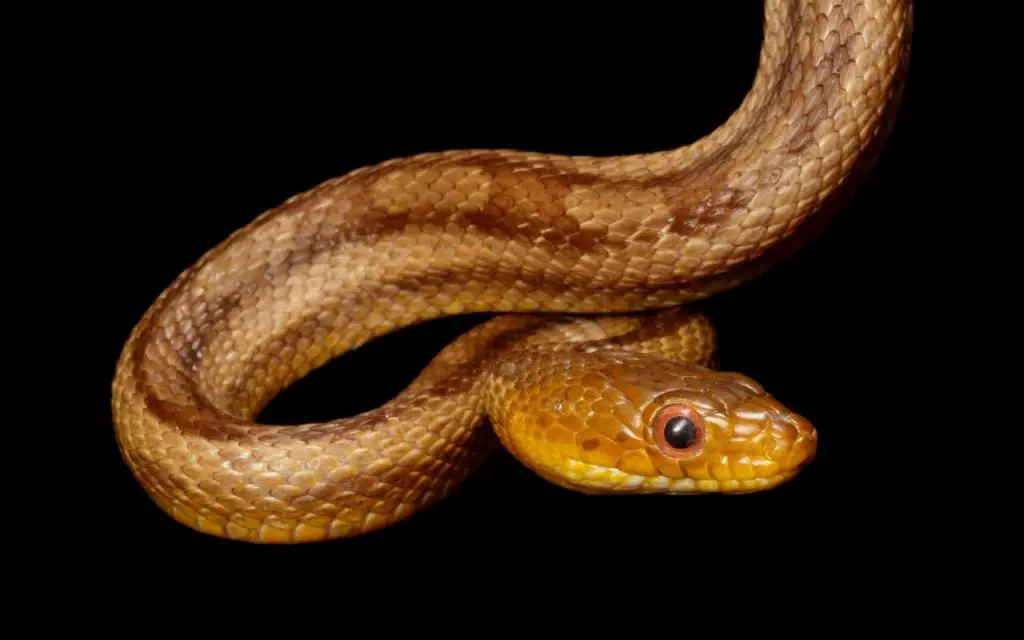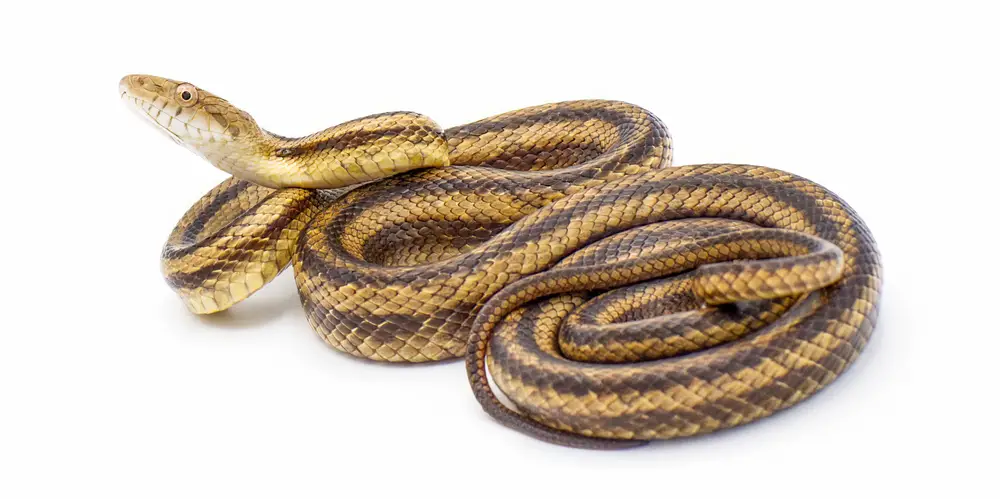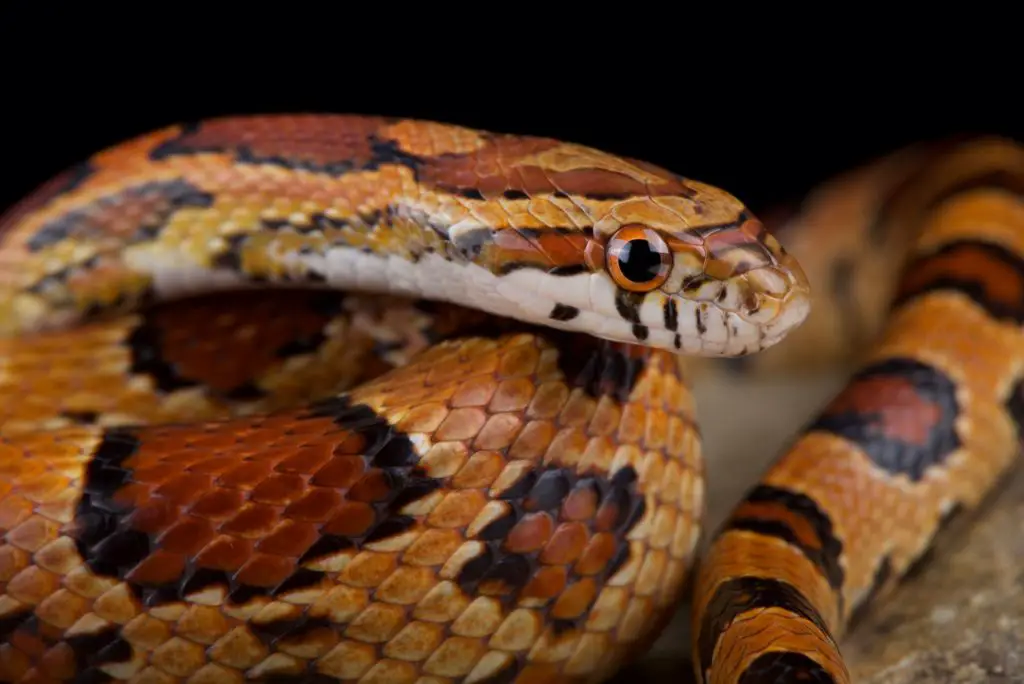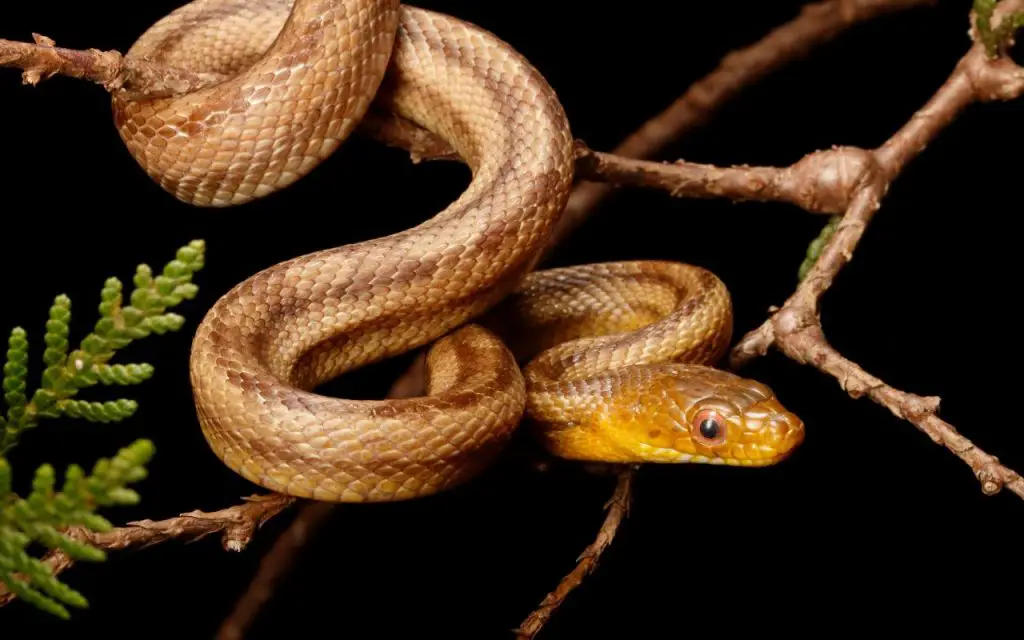In this guide to Florida Rat Snakes, we’ll take a look at the species and variants that make up this ecologically important group of snakes…
Last updated on April 7th, 2023 at 08:05 am
There are three species of Rat Snake in Florida: the Eastern Rat Snake (Pantherophis alleghaniensis), the Gray Rat Snake (Pantherophis spiloides), and the Corn Snake (Pantherophis guttatus). The Gray Rat Snake is easy to recognise, but the other two species come in a range of locality-based color variants, making identification a little more complicated.
In this article, we’re going to go through the list of Florida Rat Snakes and their color variants, giving details on their appearance, range and size. By the end of it, you’ll be able to identify them yourself in the field.
Florida Rat Snakes list
When you start researching Florida Rat Snakes, you quickly notice that there’s a ridiculous amount of common names floating around, most of which refer to color variants that were previously considered subspecies.
For example, Corn Snakes have the following common names:
- Corn Snake
- Red Rat Snake
- Rosy Rat Snake
The Eastern Rat Snake, on the other hand, has these common names:
- Eastern Rat Snake
- Yellow Rat Snake
- Everglades Rat Snake
- Chicken Snake
This is getting complicated already! So, what we’re going to do in this article is lay everything out as simply as I can. Not because I think you’ll get confused – but because I know I will if I’m not careful.
In the following infographic, I included the currently recognised species of Florida Rat Snakes, and their color variants (also called localities). After you’ve taken a look, scroll down for detailed information on each one.
As you can see, there are only three species:
- The Eastern Rat Snake (Pantherophis alleghaniensis)
- The Gray Rat Snake (Pantherophis spiloides)
- Corn Snake (Pantherophis guttatus)

1. Eastern Rat Snake (Pantherophis alleghaniensis)
The Eastern Rat Snake is one of the largest, most widespread, and most successful snakes in North America. At an adult size of 3.5 to 6 feet in length (90-182cm), they are an impressive animal to see in the wild.
They are also an impressive rodent buster, if you’re interested in pest control. Notwithstanding, they also eat a lot of squirrels and birds, given that they are semi-arboreal.
Generally speaking, they are nocturnal during good weather and often hide under debris during the day.
In Florida, Eastern Rat Snakes are variable in color, but almost always some shade of light brown or yellow. This background color is broken up by four dark brown or black longitudinal stripes.

Variant 1: the Yellow Rat Snake
The Yellow Rat Snake is the variant of Eastern Rat Snake found throughout Florida, asides from the panhandle where it’s replaced by the Gray Rat Snake.
Previously, the Yellow Rat Snake was considered a subspecies. These days, most experts agree that it’s just a color variation, but the common name has stuck in many parts.

Variant 2: the Everglades Rat Snake
This is my favorite Rat Snake, and one of my favorite snakes, period. I know – I’m supposed to be unbiased, but I just don’t think any Rat Snake can compare to a bright orange Everglades Rat Snake.
Don’t get me wrong; they aren’t all super-bright. But some are, and they are truly spectacular, especially when they get to 4 to 5 feet in length. As the name suggests, this variant is found in the Everglades and surrounding areas.

Intergrades
In parts of the panhandle, Eastern Rat Snakes interbreed with the Gray Rat Snake. The babies produced are fertile, and may occur in significant numbers.
As you might expect, they often display color and pattern characteristics of both species. They may have a light tan background, alongside dorsal saddles and faint stripes.
Identifying them can be tricky, but if you encounter any rat snake that matches this description in the eastern panhandle area, it probably is an intergrade.
Eastern Rat Snake Summary
| Range: | All of Florida, asides from the panhandle west of Apalachicola National Forest |
| Habitat: | Strong preference for forest |
| Variants present in Florida: | Yellow, Everglades |
| Activity rhythm: | Nocturnal, but crepuscular in cool weather |
| Size: | 3.5 to 6 feet in length (90-182cm) |
2. Gray Rat Snake, aka Oak Snake (Pantherophis spiloides)
Obviously, I’ve already admitted that the Everglades Rat Snake is my favorite color variant of any Florida Pantherophis species. That said, the Gray Rat Snakes from the panhandle are definitely a close contender.
Like the Eastern Rat Snake, Gray Rat Snakes are mostly black further north, but in the south they are a beautiful light gray color. In some areas they are exceptionally bright, which has earned them the nickname of White Oak Snake.
Being extremely closely related to the Eastern Rat Snake, they are also semi-arboreal, mostly nocturnal and shy. Again, their average size is around 3.5 to 6 feet in length (90-182cm) and they are opportunistic predators.
Unlike the other two species listed here, Gray Rat Snakes only come in one color variant in Florida: gray. That said, they vary considerably. Some individuals have very dark saddles, whereas others almost dazzle you.

Gray Rat Snake Summary
| Range: | Florida panhandle only, west of Apalachicola National Forest |
| Habitat: | Strong preference for forest |
| Variants present in Florida: | Gray, usually called Oak Snake or White Oak Snake |
| Activity rhythm: | Nocturnal, but crepuscular in cool weather |
| Size: | 3.5 to 6 feet in length (90-182cm) |
3. Corn Snake, aka Red Rat Snake (Pantherophis guttatus)
Last but not least, the Corn Snake is one of the brightest snakes in Florida, and one of the most popular pet snakes in the world. It is easily recognizable by its dark orange saddles on light orange background.
At a smaller overall size of 3.5-4ft (1.05-1.2m), the Corn Snake is nonetheless a true rat snake, as designated by its placement in the Pantherophis genus. It also makes up for its smaller size with extreme adaptability.
This species is semi-arboreal, but will become completely terrestrial if needs be. In fact, they seem to enter any area with a decent rodent population and call it home.
Last time I saw one in the wild, it was way out in the open, in the middle of the road in a densely populated part of Collier County. Not exactly what I would call prime semi-arboreal snake habitat!
Overall, I would consider this species to be the most adaptable rat snake species in Florida when it comes to co-existing with humans. The only way in which it is more sensitive than other rat snakes is that it tends to be more strictly nocturnal (at least in my experience).

Variant 1: the Miami Phase Corn Snake
In the Miami-Dade area, you can find the Miami phase Corn Snake. It’s not a subspecies, and never was considered one. It is however a very popular color variant with reptile keepers.
Miami Corns have nice orange to red dorsal saddles like more northerly animals, but have a grey background color instead of orange. This gives them a subtle, but very attractive appearance.

Variant 2: the Rosy Rat Snake, formerly Pantherophis guttatus rosaceum
Pantherophis guttatus rosaceum was the name given to a now defunct Corn Snake subspecies: the Rosy Rat Snake. Again, this subspecies is no longer recognized, but the common name has stuck around for Corn Snakes from the Florida Keys.
Rosy Rat Snakes often look similar to others when young, but become lighter and kind of washed-out when fully grown. Some hobbyists say they are also say are slightly smaller in overall length, though I haven’t been able to confirm this in person.

Corn Snake Summary
| Range: | All of Florida, including the keys |
| Habitat: | Anywhere, including densely populated urban areas |
| Variants present in Florida: | Miami phase, Rosy Rat Snake |
| Activity rhythm: | Nocturnal, rarely crepuscular |
| Size: | 3.5-4ft (1.05-1.2m) |
FAQ related to Florida Rat Snakes
What color are rat snakes in Florida?
The most common rat snakes in Florida are Eastern Rat Snakes which are yellow to brown, with darker black stripes. In the panhandle, that species is replaced by the Gray Rat Snake, which is light gray with darker blotches. Another Rat Snake – the Corn Snake – is also found throughout Florida. This species is much brighter though, being various shades of orange and red.
How big do Florida rat snakes get?
Corn Snakes rarely get more than 4ft (1.20m) long, and an average size is around 3.5ft (1.05m). The other two species present in Florida get both longer and stockier. In fact, the Eastern Rat Snake and Gray Rat Snake are some of the largest snakes in North America, often reaching 3.5 to 6 feet in length (90-182cm), and occasionally over 7ft (213cm).
Are eastern rat snakes aggressive?
Eastern Rat Snakes are not aggressive. They almost always pick retreat, as opposed to standing their ground and fighting. On the rare occasion that they do feel cornered enough to fight back, they usually do an elaborate threat display. It includes rattling their tail against leaves, hissing, rearing up in an “S”, and mock striking. Overall, it’s safe to say they’ll try anything rather bite.
Is an oak snake venomous?
Oak Snakes, also known as Gray Rat Snakes are not venomous. Being shy rodent predators, they are harmless to humans and hugely beneficial to the environment. Before harming one or removing it from your property, remember that it’s there on business: pest control!

